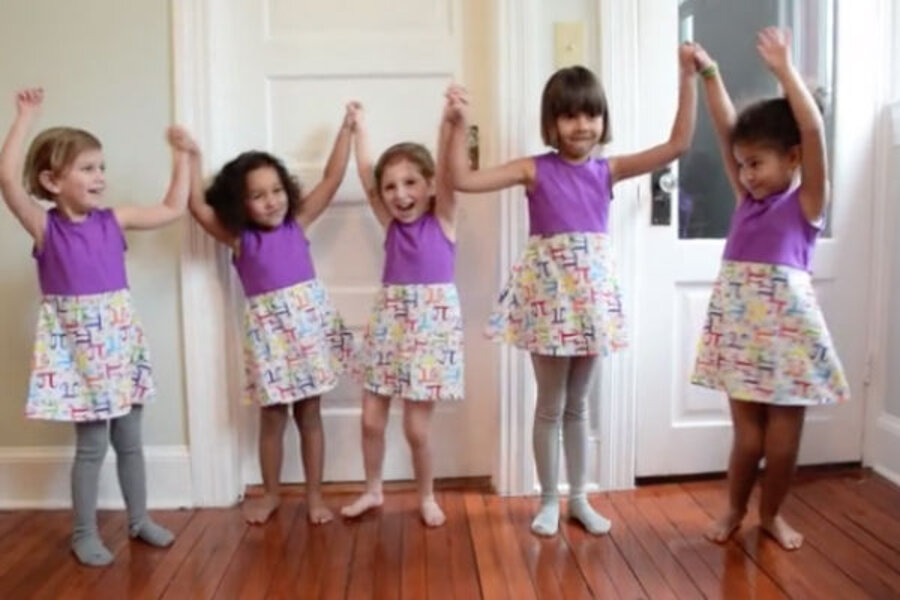Princess Awesome dresses show a tipping point for parents
Loading...
It’s a familiar story: A mom, shopping for clothing for her two-year-old daughter, sees nothing but gender-stereotypical offerings. To give her little girl some diverse choices, she ignores the girls’ and boys’ signs, and buys a few items from each department.
I remember my mom doing this for me in the 1980s, in order to get me a shirt with my beloved Mickey Mouse on it (which for some reason was only available in the boys’ section).
I remember moms doing this for the little girls I interviewed for my "Growing Up With Girl Power" book around 2005, in order to get their daughters science-themed shirts.
And I have been doing this for my own sons since 2008, seeking out non-stereotypical options in both departments — with favorite finds including a cute bomber jacket and an epic black-and-white print Madonna “Who’s That Girl 1987 World Tour” t-shirt, which my son rocked at age three. Both were in the girls’ department, rather than the boys’, even though they struck me as delightful gender-neutral items.
But Rebecca Melsky, like a few other brave and entrepreneurial parents before her, went one step further: After a fatefully frustrating shopping trip for her two-year-old in 2013, Ms. Melsky and her friend Eva St. Clair decided to do something. In the same spirit as their entrepreneurial predecessors who created t-shirts, books, and dolls, Melsky and Ms. St. Clair took on a different challenge: girls’ dresses.
The dresses they designed break the pink frilly dress mold with aplomb, featuring equal parts style and cleverness.
In this way, Princess Awesome – a small, indie, mom-owned business – was born. Two years passed, and Melsky and St. Clair could not keep up with demand: People wanted more of their well-designed, colorful dresses than they could sew. So, on February 3, 2015, Princess Awesome launched a month-long Kickstarter campaign to move their brand into factory production, with a goal of raising $35,000.
Kickstarter tells its campaigners that when they receive one-third of their funding in three days, that’s a good predictor of success.
Consider the significance, then, of the fact that Princess Awesome was fully funded in three days—and that now, 14 days later, they’re surpassed the $125,000 mark.
In the meantime, their incredible designs have gone viral. They’ve been featured everywhere from the Huffington Post to BuzzFeed News, and when I shared their campaign with my own Facebook community on the day their Kickstarter launched, my readers reacted with palpable excitement.
“OMG, my girls would have LOVED this!” one mom said. “We did ballet dancers and fairies, but that was about as far as anyone could stand—and only in bed sheets.”
“Yes!” exclaimed another. “I know my LO would love a dinosaur dress.”
“I like cute pink dresses for little girls but I also like options,” noted another. “Can’t wait to buy these one day when I have a daughter too.”
Even Brenda Chapman, director of Disney/Pixar’s "Brave" weighed in: “A kickstarter I think all princesses could get behind! Thanks for sharing, Rebecca Hains!”
Melsky and St. Clair are delighted and perhaps a bit surprised to see that they’ve stuck a chord with so many people. “When we were just starting out and told people our concept for Princess Awesome, almost every single person said, ‘That’s a fantastic idea!’,” Melsky reflects. “We figured that when we launched the Kickstarter we’d find out if people were just humoring us or if we’d really hit a nerve. I’m pretty sure at this point we can say that people weren’t just humoring us.
“Our Kickstarter message inbox is filled with people telling us about their daughters who love all sorts of things—tutus, trucks, Ninja Turtles, math, dinosaurs,” she adds. “They keep saying how happy they are to have some dress choices that honor that range of interests.”
The public’s enthusiastic response to the Princess Awesome dresses raises an interesting question: Why are people so excited about this option—and why now?
From my perspective, the groundswell of support for Princess Awesome tells us something important about our current cultural context. Today’s girls face a strikingly monochromatic girlhood. As I explain in my book "The Princess Problem: Guiding Our Girls Through the Princess-Obsessed Years," the dominance of pink frilly dresses and other stereotypically pink products exploits a developmental stage called “appearance rigidity.”
During this stage, about two-thirds of little girls – unsure what makes boys boys or girls girls, and unsure of the permanence of their sex, and therefore a little nervous about whether using “boys'” items could turn them into boys – attach themselves to the most stereotypically girlish items they can find. In so doing, they are announcing to the world that they are girls and proud of it, as they celebrate and cement their identities as girls.
Marketers know this, and so girls’ products in all categories, from apparel to toys to home goods, have become dominated by the color pink. After all, the color pink is like low-hanging fruit: It’s an easy and lazy way for marketers to declare, “Hey, girls, this is for you!”
Unfortunately, monochromatic girlhood drives a wedge between boys and girls – separating their spheres during a time when cross-sex play is healthy and desirable, and when their imaginations should run free.
Meanwhile, marketers (and some critics of the girl empowerment movement) blame parents for the very situation the marketers themselves have created. If parents would vote with their dollars and stop buying stereotypical items and boycott the pinkification of previously gender-neutral items (like wagons and infants’ stacking rings and globes), they say, the marketplace would respond. Then, and only then, girls will have real choices once again.
Many indie clothing brands and their supporters have heeded these words, fighting back against monochromatic girlhood and the stereotypical division of the sexes by creating clever unisex items, like t-shirts in colors and designs that are meant for boys and girls alike.
But thanks to the developmental phase I mentioned earlier, many little girls favor dresses over t-shirts (and many parents do, too). After all, a dress announces to the world that its wearer is a girl, which means that by wearing a dress, girls can celebrate girlhood. Plus, dresses are undeniably pretty, and fun to twirl in – and play dress like those offered by Princess Awesome are easy to move and run in, and look nice with leggings, too. For some families, then, gender-neutral tee-shirts don’t always fit the bill, and they’re not always that easy to find, either. Parents need to have a bit of cultural capital to locate indie brands in the first place.
Princess Awesome is arguably the first serious alternative to stereotypically girly-girl dresses to enter the marketplace in recent years. Given parents’ increasing frustration with princess culture and girls’ constricted, stereotypical, pink-upon-pink “options,” Princess Awesome’s timing is perfect. Perhaps it’s even the harbinger of a new zeitgeist.
Lori Day, a psychologist and educational consultant who authored "Her Next Chapter: How Mother-Daughter Book Clubs Can Help Girls Navigate Malicious Media, Risky Relationships, Girl Gossip, and So Much More," agrees. “I think one of the reasons Princess Awesome is hitting it right now is that in today’s girl culture, we have a spectrum with much-needed brands like Princess Free Zone on one end – featuring clothes for girls who want nothing to do with dresses or girly. On the other end is the super girly-girl style – all pink and Disney gowns,” she explains.
“But,” Ms. Day adds, “the middle is a popular place to be right now. Think of how many moms say, ‘My daughter is girly and likes to wear dresses and collect bugs,’ or ‘My girl plays in the mud in her Belle gown.’ Princess Awesome taps right into the ‘my daughter likes princess and…‘ concept: girly dresses with neutral or traditionally ‘male’ themes in the fabric.”
In short, the Princess Awesome Kickstarter campaign has gone viral because there is indeed an unmet need for clever, non-stereotypical, vibrantly colored little girls’ dresses in the marketplace. They juxtapose stereotypically boyish themes with traditionally girlish stylings – which some readers may recall as the formula that led girl power to success in the late 1990s.
Princess Awesome’s traction may be read as a cultural referendum on the relentlessly monochromatic girly girl culture we’ve lived with for more than a decade – a signal that we’re approaching a cultural tipping point on the subject. And that’s a good thing.
The Christian Science Monitor has assembled a diverse group of the best family and parenting bloggers out there. Our contributing and guest bloggers are not employed or directed by the Monitor, and the views expressed are the bloggers' own, as is responsibility for the content of their blogs. Rebecca Hains blogs at rebeccahains.com/blog.








